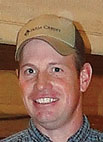
Justin and Chana Usrey and their two sons, Kenny, 11, and Darrin, 8, live outside of Huntsville, Ark., where they raise turkeys and a commercial cattle herd. The couple married in 2000 and purchased 78 acres and another 30 later. They also rent an additional 320 acres and are considering expanding that acreage.
After high school Justin went to farrier school to begin a part-time career and to alleviate the need to pay for having his own horses shod. The position, however, soon turned into a full-time job which he has just recently been able to eliminate completely.
After college Chana bought 2 acres from her parents and opened a convenience store/gas station named Chana’s Corner, which provides a good supplemental income used for family expenses.
The Usreys have one brooding house and two growing houses, which hold 32,000 Cargill turkeys at a time. They currently raise toms which grow to an average of 40 to 45 pounds. The first flock Cargill gave them, however, was of hens because they matured in only 12 weeks rather than the usual 20 weeks for toms to promote cash flow for the new turkey farmers. A 40-pound bird provides a 27-29 pounds of meat.
When a new batch of poults arrive, they are divided into pens with 800 poults per pen. The new chicks are hand fed twice a day for two weeks and turned out into the full house after one week. After the initial two-week period, the hand feeders are pulled out with the level being raised two or three times per week. In a total of seven or eight weeks the young poults are transitioned into the growing houses.
Transferring can be a challenging process. Initially the Usreys had alleyways between the houses, and the turkeys had to be shooed to the houses in small batches of approximately 75. Moving the 16,000 young birds was therefore a time-consuming process. Although still time-consuming, the process has been sped up through the purchase and use of a new moving trailer, which contains a conveyor belt system and moves about 400 birds at a time.
In the growing houses, feeder heights are adjusted once per week until the turkeys are about 15 weeks old and have reached maximum height. Turkeys are really fast growing animals. One big adjustment for the birds after transition is the change in light because only white light is used in the brooding house while the birds have to adapt to natural sunlight as well as dimmer artificial light in the growing houses.
As with all poultry, disease is an issue with a 5 to 6 percent loss due to cellulitis being typical. Cargill is running several projects in an attempt to decrease this loss. The Usrey farm is involved in one, which requires spraying the floor of the houses once per week from 8 to 18 weeks of age. Kenny said, “Darren and I wave red and orange flags which startles the birds and helps us shoo them away from dad who follows behind with his sprayer.” Justin then added, “The initial results look good but further testing and analysis are needed and must be compared with the results of the other projects.”
The Usrey commercial cattle herd consists of 70 mommas with heavy Angus influence. They are bred to purebred Hereford bulls. Chana likes the cross because she believes the cross is more marketable, and, while Justin readily admits the advantage of hybrid vigor, he also simply likes the black baldy appearance.
Last year Kenny bought a show heifer from the Farm Credit Service youth loan program and earned almost enough money at Madison County Fair premium sale to pay back the loan. Kenny also plans on showing the cow and her calf next year while Darren is getting ready to purchase his first heifer.
Justin said, “We are young and have not put a cap on our growth. We will expand as much as financing and productivity allow.”







